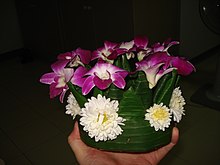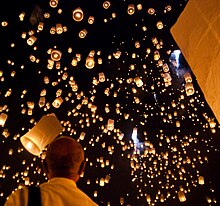Loy Krathong
| Loy Krathong | |
|---|---|
Ganga, worship the Buddha's hair pagoda in the heaven[2] | |
| Date | Full moon of the 12th Thai month |
| 2023 date | 27 November[3] |
| 2024 date | 15 November[4] |
| Frequency | Annual |
| Related to | Tazaungdaing festival (in Myanmar), Mid-Autumn Festival (in China),, Bon Om Touk (in Cambodia), Il Poya (in Sri Lanka), Boita Bandana (in Odisha, India) |
Loy Krathong (
Loy Krathong takes place on the evening of the full moon of the 12th month in the traditional Thai lunar calendar, thus the exact date of the festival changes every year. In the Western calendar this usually falls in the month of November. In Chiang Mai, the festival lasts three days, and in 2018, the dates were 21–23 November.
In Thailand, the festival is known as Loi Krathong. Outside Thailand, this festival is celebrated under different names, including Myanmar as the "Tazaungdaing festival", Sri Lanka as "Il Full Moon Poya", China as "Lantern Festival" and Cambodia as "Bon Om Touk".[7][8][9][10][11]
Overview


A krathong is traditionally a small floating container fashioned of leaves which is made to hold a small portion of goods like a traditional Thai dish (such as hor mok) or dessert. The traditional krathong used for floating at the festival are made from a slice of a banana tree trunk or a

Loy Krathong possibly originated from Angkor in Khmer Empire. Walls of Bayon, a temple built by King Jayavarman VII in the 12th century, depicts scenes of Loy Krathong. A bas relief on the upper level depicts a queen residing on the boat to float the krathong in the river whereas six other royal concubines are depicted below, some of which are holding the krathong and dedicating at the riverbank in a similar tradition practiced in present-day Cambodia, Thailand, and other Southeast Asian countries.[14][15][16] Similarities can be observed with
Etymology
According to the 1999 Royal Institute Dictionary, loi (
History

Legend in Sukhothai Kingdom Period
Loy Krathong is once said to have begun in the
Ayutthaya Kingdom and Lavo Kingdom Period
"The Siameſes have alſo ſome Religious Shows. When the Waters begin to retreat, the People returns them Thanks for ſeveral Nights together with a great Illumination; not only for that they are retired, but for the Fertility which they render to the Lands. The whole River is then ſeen cover'd with floating Lanthorns which paſs with it. There are of different Sizes, according to the Devotion of every particular Perſon; the variouſly painted Paper, whereof they are made, augments the agreeable effect of ſo many lights. Moreover, to thank the Earth for the Harveſt, they do on the firſt days of their Year make another magnificent Illumination. The firſt time we arriv'd at Louvo was in the Night, and at the time of this Illumination; and we ſaw the Walls of the City adorned with lighted Lanthorns at equal diſtances; but the inſide of the Palace was much more pleaſant to behold. In the Walls which do make the Incloſures of the Courts, there were contrived three rows of ſmall Niches all round, in every of which burnt a Lamp. The Windows and Doors were likewiſe all adorn'd with ſeveral Fires, and ſeveral great and ſmall Lanthorns, of different Figures, garniſhed with Paper, or Canvas, and differently painted, were hung up with an agreeable Symmetry on the Branches of Trees, or on Poſts."― Simon de la Loubère.
Rattanakosin Kingdom Period
The beauty contests that accompany the festival are known as "Nopphamat Queen Contests" has been promoted since the reign of
Lanna Kingdom Period and later Northern Part of Thailand

Loy Krathong coincides with the
Swarms of sky lanterns (Thai: โคมลอย; RTGS: khom loi), literally: 'floating lanterns', are launched into the air. Khom loi are made from a thin fabric, such as rice paper, stretched over a bamboo or wire frame, to which a candle or fuel cell is attached. When the fuel cell is lit, the resulting hot air is trapped inside the lantern and creates enough lift for the khom loi to float into the sky. During the festival, some people also decorate their houses, gardens, and temples with khom fai (Thai: โคมไฟ), intricately shaped paper lanterns which take on different forms. Khom thue (Thai: โคมถือ) are lanterns which are carried around hanging from a stick, khom khwaen (Thai: โคมแขวน) are the hanging lanterns, and khom pariwat (Thai: โคมปริวรรต), which are placed at temples and which revolve due to the heat of the candle inside. The most elaborate Yi Peng celebrations can be seen in Chiang Mai,[33] the ancient capital of the former Lanna kingdom, where now both Loy Krathong and Yi Peng are celebrated at the same time resulting in lights floating on the waters, lights hanging from trees/buildings or standing on walls, and lights floating in the sky. The tradition of Yi Peng was also adopted by certain parts of Laos during the 16th century.
The aftermath
In 2016, the Bangkok Metropolitan Administration (BMA) cleaned six tonnes of rubbish from the city's waterways on the day after Loy Krathong. The city governor said that 661,935 floats were collected from waterways across Bangkok. Of these, 617,901 (93.7 percent) were made of decomposible natural materials, while 44,034 were non-biodegradable Styrofoam floats. There were 163,679 fewer krathong collected than in 2015. The city mobilized 210 workers and 45 boats to collect floats from the Chao Phraya River and canals.[34]
In 2017, because the
In 2017, in
In 2018, after the festivities, Bangkok city workers cleared 841,327 krathongs, up from 3.6 percent in 2017, from the Chao Phraya River, local canals, and 30 public parks; 5.3 percent of them were made from styrofoam.[38]
Gallery
-
Loy Krathong Festival, Chiang Mai
-
Loy Krathong Festival
-
Partially made krathong, showing trunk of banana tree and banana leaves
-
Loy krathongs or floating lanterns at Koh Samui
-
Loy Krathong, Chiang Mai
-
Loy Krathong 2007, Lumpini Park, Bangkok
-
Loy Krathong 2007, Lumpini Park, Bangkok
-
Launching khom loi, Yi Peng Festival, Mae Cho, Chiang Mai
-
Launching a lantern
-
-
Loy Krathong 2014
See also
- Public holidays in Thailand
- Thai folklore
- Similar festivals
- Tazaungdaing festival – Myanmar equivalent of Loy Krathong
- Mid-Autumn Festival - Chinese autumn lantern festival where the water lantern or lamp has been used for floating
- Boita Bandana – Odia autumn festival when people float miniature boats with lighted lamps (diyas) on the rivers/sea.
- Diwali – Indian light festival
- Karthika Deepam - festival of lights observed in Kerala, Tamil Nadu and Sri Lanka.
- Tōrō nagashi– Japanese lantern festival
- Leaf boat
- Thanksgiving
Notes
- ^ Alternative spellings include Loi Kratong, Loy Gratong, etc.
References
- ^ "ประเพณี ลอยกระทง" [Loi Krathong tradition]. Ministry of Culture (in Thai). 22 January 2015. Archived from the original on 28 July 2020. Retrieved 10 November 2019.
- ^ ธนากิต. ประเพณี พิธีมงคล และวันสำคัญของไทย. กรุงเทพฯ : ชมรมเด็ก, ๒๕๓๙.
- ^ "วันลอยกระทง 2566 วันที่เท่าไร มีจังหวัดไหนจัดงานบ้าง". Thairath (in Thai). 8 November 2023. Archived from the original on 14 November 2023.
- ^ "Loi Krathong Festival 2022". Tourism Authority of Thailand. 28 October 2022. Archived from the original on 28 October 2022.
- ^ Argawal Ruchi (January 2009). "Water Festivals of Thailand: The Indian Connection". Silpakorn University Journal of Social Sciences, Humanities, and Arts. 9–10 (1): 1, 17.
- ISBN 978-1-5988-4206-7. Retrieved 15 February 2014.
- ISBN 9780141955049– via Google Books.
- ^ "Buddhist Calendar - Southeast Asian Calendars - Thai Calendar".
- ^ "Pictures of the day: 23 October 2016". The Telegraph. 23 October 2016.
- ^ "Il Poya". 12 September 2014. Archived from the original on 7 November 2017. Retrieved 26 December 2016.
- ^ "Discover the full moon festival of Cambodia, Thailand and Myanmar". 1 February 2017. Archived from the original on 1 February 2017.
- ISBN 9786162222641.
- ^ a b "No urban place for Loy Krathong" (Opinion). Bangkok Post. 18 November 2018. Retrieved 18 November 2018.
- ^ เหล่ามานะเจริญ, ศิริพจน์ (17 November 2016). "ตำแหน่งท้าวศรีจุฬาลักษณ์ ของนางนพมาศ ไม่ใช่ตำแหน่งของราชสำนักสุโขทัย". มติชนสุดสัปดาห์ (in Thai). Retrieved 3 October 2020.
- ^ วงษ์เทศ, สุจิตต์ (6 November 2017). "สุจิตต์ วงษ์เทศ : ลอยกระทงเพื่อชาติของกบในกะลา". มติชนออนไลน์ (in Thai). Retrieved 3 October 2020.
- ^ "สุจิตต์ วงษ์เทศ : 'ลอยกระทง' มีครั้งแรกสมัย ร.3 สระน้ำในเมืองเก่าสุโขทัย ไม่ขุดไว้ลอยกระทง". www.matichonweekly.com. Retrieved 3 October 2020.
- ^ "Loi Krathong". Archived from the original on 19 October 2020. Retrieved 4 November 2020.
- ^ "Baxter-Sagart Old Chinese reconstruction" (PDF).
- ^ Wei, L. (2010). Chinese festivals: traditions customs and rituals [L. Yue & L. Tao, trans]. Beijing: China International Press, p. 51. (Call no.: R 394.26951 WEI-[CUS]); Latsch, M-L. (1985).
- ^ "放水燈". Archived from the original on 26 December 2013. Retrieved 25 December 2013.
- ^ "施餓鬼舟". Archived from the original on 26 December 2013. Retrieved 25 December 2013.
- ^ "施餓鬼(せがき)舟". Archived from the original on 26 December 2013. Retrieved 25 December 2013.
- ^ Pittayaporn, Pittayawat (2014), “Layers of Chinese Loanwords in Proto-Southwestern Tai as Evidence for the Dating of the Spread of Southwestern Tai”, in MANUSYA: Journal of Humanities, volume 20 (special issue), Bangkok: Chulalongkorn University, ISSN 0859-9920, pages 47–68
- ^ Bilmes, L. (1998). The /ka-/ and /kra-/ prefixes in Thai. Linguistics of the Tibeto-Burman Area, 21 (2), 73-96.
- ^ "คำอธิบายศัพท์". vajirayana.org. 8 March 2017. Retrieved 30 October 2020.
- ^ "ลอยกระทงปีนี้..กี่กระทงดีคะ". www.thairath.co.th (in Thai). 22 November 2018. Retrieved 30 October 2020.
- ^ “kantong” in Kamus Besar Bahasa Indonesia, Jakarta: Language Development and Fostering Agency — Ministry of Education, Culture, Research, and Technology of the Republic Indonesia, 2016.
- ^ "คณะวิทยาศาสตร์และเทคโนโลยี : Faculty of Science and Technology". Archived from the original on 28 June 2010. Retrieved 22 September 2010.
- ISBN 0313308640. Retrieved 15 October 2017.
- ISBN 9743236244. Retrieved 21 September 2021.
- ^ Phya Anuman Hajthon. "The Loi Krathons" (PDF). Journal of the Siam Society: 64.
- ^ สาระน่ารู้เกี่ยวกับประเพณียี่เป็งล้านนา [Info about Lanna's Yi Peng] (in Thai). Chiang Rai Provincial Culture Office. 2004. Archived from the original on 10 April 2014. Retrieved 6 June 2014.
- ^ "Lantern Festival of the Yee Peng Month". Archived from the original on 28 February 2013.
- ^ a b "City cleans 6 tonnes of krathong waste". Bangkok Post. 16 November 2016. Retrieved 16 November 2016.
- ^ Atthakor, Ploenpote (1 November 2017). "Loy Krathong must be kept under control". Bangkok Post. Retrieved 1 November 2017.
- ^ "Police and City Hall say no fireworks, firecrackers or sky lanterns on Loy Krathong Day". Thai PBS. 30 October 2017. Retrieved 31 October 2017.
- ^ "Up to 158 flights cancelled amid air safety fears". Bangkok Post. 22 November 2018. Retrieved 22 November 2018.
- ^ "Styrofoam krathong numbers sink". Bangkok Post. 24 November 2018. Retrieved 24 November 2018.
External links
- Sukhothai celebrations
- Tourism Authority of Thailand (TAT) Loi Krathong Information
- Suttinee Yavaprapas; Chaleo Manilerd; Thailand. Krasūang Watthanatham. External Relations Division; Thailand. Krasūang Watthanatham. Office of the Permanent Secretary (2004). Loy Krathong Festival. Ministry of Culture, External Relations Division. ISBN 978-974-9681-22-0. Retrieved 5 October 2011.
- Donald K. Swearer (1 February 2010). The Buddhist world of Southeast Asia. ISBN 978-1-4384-3251-9. Retrieved 5 October 2011.
- Anuman Rajadhon (Phrayā) (1956). Loy krathong & Songkran festival. National Culture Institute. Retrieved 5 October 2011.
- The Kingdom of the Yellow Robe. Forgotten Books. pp. 358–367. ISBN 978-1-4400-9096-7. Retrieved 5 October 2011.











